Abstract
In Europe, computation of displacement demand for seismic assessment of existing buildings is essentially based on a simplified formulation of the N2 method as prescribed by Eurocode 8 (EC8). However, a lack of accuracy of the N2 method in certain conditions has been pointed out by several studies. This paper addresses the assessment of effectiveness of the N2 method in seismic displacement demand determination in non-linear domain. The objective of this work is to investigate the accuracy of the N2 method through comparison with displacement demands computed using non-linear time-history analysis (NLTHA). Results show that the original N2 method may lead to overestimation or underestimation of displacement demand predictions. This may affect results of mechanical model-based assessment of seismic vulnerability at an urban scale. Hence, the second part of this paper addresses an improvement of the N2 method formula by empirical evaluation of NLTHA results based on EC8 ground-classes. This task is formulated as a mathematical programming problem in which coefficients are obtained by minimizing the overall discrepancy between NLTHA and modified formula results. Various settings of the mathematical programming problem have been solved using a global optimization metaheuristic. An extensive comparison between the original N2 method formulation and optimized formulae highlights benefits of the strategy.
Similar content being viewed by others
References
Abrahamson NA (1992), “Non-Stationary Spectral Matching,” Seismological Research Letters, 63(1): 30.
Albidah AS, Altheeb AH, Lam NTK and Wilson JL (2015), “Modelling Non-Linear Behaviour of Lightly Reinforced Concrete Walls,” Proceedings of the Tenth Pacific Conference on Earthquake Engineering “Building an Earthquake Resilient Pacifics, 6–8 November 2015, Sydney, Australia.
Allahabadi R and Powell GH (1988), “Drain-2DX User Guide,” Report No. UCB/EERC-88/06, College of Engineering, University of California, Berkeley.
Amadio C, Rinaldin G and Fragiacomo M (2016), “Investigation on the Accurancy of the N2 Method and the Equivalent Linearization Procedure for Different Hysteretic Models,” Soil Dynamics and Earthquake Engineering, 83: 69–80.
Ambraseys N, Smit P, Sigbjornsson R, Suhadolc P and Margaris B (2002), Internet Site for European Strong-Motion Data, European Commission, Research Directorate General, Environment and Climate Program.
ATC (Applied Technology Council) (2005), FEMA 440-Improvement of Nonlinear Static Seismic Analysis Procedures, By: Department of Homeland Security Federal Emergency Management Agency.
Bertsekas DP (1999), Nonlinear Programming, Belmont, MA: Athena Scientific.
Bertsimas D and Tsitsiklis JN (1997), Introduction to Linear Optimization, Vol. 6, Belmont, MA: Athena Scientific.
Brachetti P et al. (1997), “A New Version of the Price’s Algorithm for Global Optimization,” Journal of Global Optimization, 10(2): 165–184.
CEN (Comité Européen de Normalisation) (2004), Eurocode8: Design Provisions for Earthquake Resistance of Structures-Part 1: General Rules, Seismic Actions and Rules for Buildings, EN 1998–1:2004.
Fajfar P and Fischinger M (1988), “N2-a Method for Non-Linear Seismic Analysis of Regular Buildings,” Proceedings of Ninth World Conference on Earthquake Engineering, August 2–9 1988, Tokyo–Kyoto, Japan (Vol. V).
Fajfar P (2000), “A Nonlinear Analysis Method for Performance Based Seismic Design,” Earthquake Spectra, 16(3): 573–592.
Fogel DB (2006), Evolutionary Computation: Toward a New Philosophy of Machine Intelligence, Vol. 1. John Wiley & Sons.
Graziotti F, Penna A, Bossi E and Magenes G (2014), “Evaluation of Displacement Demand for Unreinforced Masonry Buildings by Equivalent SDOF Systems,” Proceedings of the 9th International Conference on Structural Dynamics, EURODYN 2014, Porto, Portugal, 30 June 2014, Cunha A, Caetano E, Muller G (eds).
Guerrini G, Graziotti F, Penna A and Magenes G (2017), “Improved Evaluation of Inelastic Displacement Demands for Short-Period Masonry Structures,” Earthquake Engineering & Structural Dynamics, 46(9): 1411–1430.
Lagomarsino S and Giovinazzi S (2006), “Macroseismic and Mechanical Models for the Vulnerability and Damage Assessment of Current Buildings,” Bulletin of Earthquake Engineering, 4(4): 415–433.
Leonetti M, Kormushev P and Sagratella S (2012), “Combining Local and Global Direct Derivative-Free Optimization for Reinforcement Learning,” Cybernetics and Information Technologies, 12(3): 53–65.
Lestuzzi P (2002), “Effective Stiffness of RC Walls in Dynamic Tests,” Proceedings of the 12th European Conference on Earthquake Engineering, Paper reference 861, London
Lestuzzi P, Belmouden Y and Trueb M (2007), “Non-Linear Seismic Behaviour of Structures with Limited Hysteretic Energy Dissipation Capacity,” Bulletin of Earthquake Engineering, 5(4): 549–569.
Lestuzzi P and Badoux M (2003a), “An Experimental Confirmation of The Equal Displacement Rule for RC Structural Walls,” Proceedings of the Fib-Symposium: Concrete Structures in Seismic Regions, Paper No. 127, May 6–8, 2003, Athens, Greece.
Lestuzzi P and Badoux M (2003b), “The Gamma Model: a Simple Hysteretic Model for RC Walls,” Proceedings of the fib-Symposium: Concrete Structures in Seismic Regions, Paper No. 126, May 6–8, 2003, Athens, Greece.
Lestuzzi P and Badoux M (2008), Génie Parasismique, Conception et Dimensionnement des Batiments, Presses Polytechniques et Universitaires Romandes. (in French)
Lestuzzi P et al. (2016), “Seismic Vulnerability Assessment at Urban Scale for Two Typical Swiss Cities Using Risk-UE Methodology,” Natural Hazards, 84(1): 249–269.
Lin Y and Miranda E (2008), “Noniterative Equivalent Linear Method for Evaluation of Existing Structures,” J. Struct. Eng., 134(11): 1685–1695.
Linda AA and Abrahamson NA (2010), “An Improved Method for Nonstationary Spectral Matching,” Earthquake Spectra, 26(3): 601–617.
Litton RW (1975), “A Contribution to the Analysis of Concrete Structures under Cyclic Loading,” Ph.D. Thesis, Civil Engineering Dept., University of California, Berkeley.
Martinelli E and Faella C (2015), “Nonlinear Static Analyses Based on Either Inelastic or Elastic Spectra with Equivalent Viscous Damping: A Parametric Comparison,” Engineering Structures, 88: 241–250.
Michel C, Lestuzzi P and Lacave C (2014), “Simplified Non-Linear Seismic Displacement Demand Prediction for Low Period Structures,” Bulletin of Earthquake Engineering, 12(4): 1563–1581.
Miranda E and Bertero V (1994), “Evaluation of Strength Reduction Factors for Earthquake-Resistant Design,” Earthquake Spectra, 10(2): 357–379.
Newmark NM and Hall WJ (1973), “Seismic Design Criteria for Nuclear Reactor Facilities,” Report No. 46, Building Practices for Disaster Mitigation, National Bureau of Standards, U.S. Department of Commerce, 209–236.
Oropeza M, Favez P and Lestuzzi P (2010), “Seismic Response of Nonstructural Components in Case of Nonlinear Structures Based on Floor Response Spectra Method,” Bulletin of Earthquake Engineering, 8(2): 387–400.
Otani S (1974), “Inelastic Analysis of R/C Frame Structures,” Journal of the Structural Division, 100(7): 1433–1449.
Riddell R, Hidalgo P and Cruz E (1989), “Response Modification Factors for Earthquake-Resistant Design of Short Period Structures,” Earthquake Spectra, 5(3): 571–590.
Ruiz-Garcia JN and Miranda E (2003), “Inelastic Displacement Ratios for Evaluation of Existing Structures,” Earthquake Engineering and Structural Dynamics, 32(8): 1237–1258.
Saiidi M and Sozen MA (1981), “Simple Nonlinear Seismic Analysis of R/C Structures,” Journal of the Structural Division, Proceedings of the American Society of Civil Engineers (ASCE), 107(ST5): 937–952.
Schwab P and Lestuzzi P (2007), “Assessment of the Non-Linear Seismic Behaviour of Ductile Wall Structures due to Synthetic Earthquakes,” Bulletin of Earthquake Engineering, 5(4): 67–84.
Storn R and Price K (1997), “Differential Evolution-a Simple and Efficient Heuristic for Global Optimization over Continuous Spaces,” Journal of Global Optimization, 11(4): 341–359.
Takeda T, Sozen MA and Nielsen NN (1970), “Reinforced Concrete Response to Simulated Earthquakes,” Journal of the Structural Division, ASCE, 96(12): 2557–2573.
Vaculik J, Lumantarna E, Griffith M, Lam N and Wilson J (2007), “Dynamic Response Behaviour of Unreinforced Masonry Walls Subject to Out of Plane Loading,” Proceedings of 2007 Australian Earthquake Engineering Society Conference, pp. 1–8, Wollongong, NSW.
Veletsos A and Newmark N (1960), “Effect of Inelastic Behavior on the Response of Simple Systems to Earthquake Motion,” In: 2nd World Conference on Earthquake Engineering, 2: 895–912. Tokyo, Japan.
Vidic T, Fajfar P and Fischinger M (1994), “Consistent Inelastic Design Spectra: Strength and Displacement,” Earthquake Engineering and Structural Dynamics, 23(5): 507–521.
Author information
Authors and Affiliations
Corresponding author
Rights and permissions
About this article
Cite this article
Diana, L., Manno, A. & Lestuzzi, P. Seismic displacement demand prediction in non-linear domain: Optimization of the N2 method. Earthq. Eng. Eng. Vib. 18, 141–158 (2019). https://doi.org/10.1007/s11803-019-0495-8
Received:
Accepted:
Published:
Issue Date:
DOI: https://doi.org/10.1007/s11803-019-0495-8




